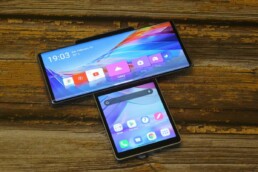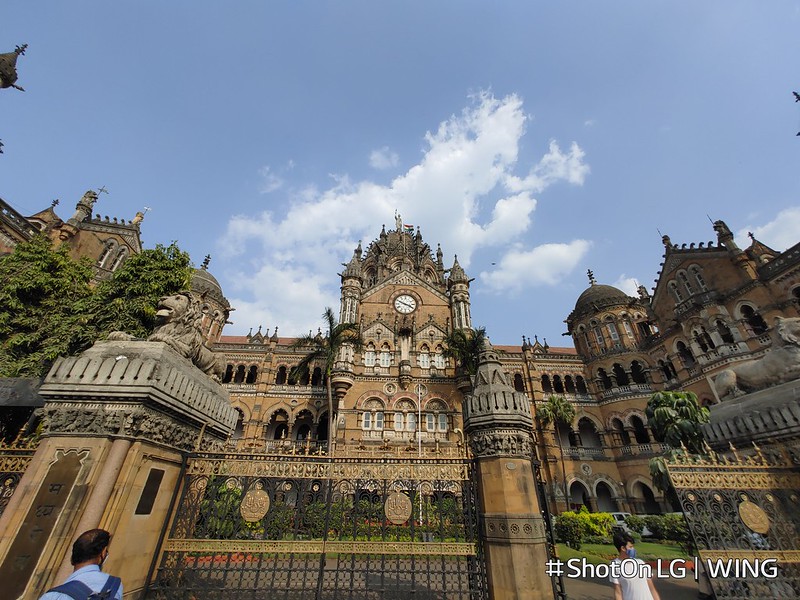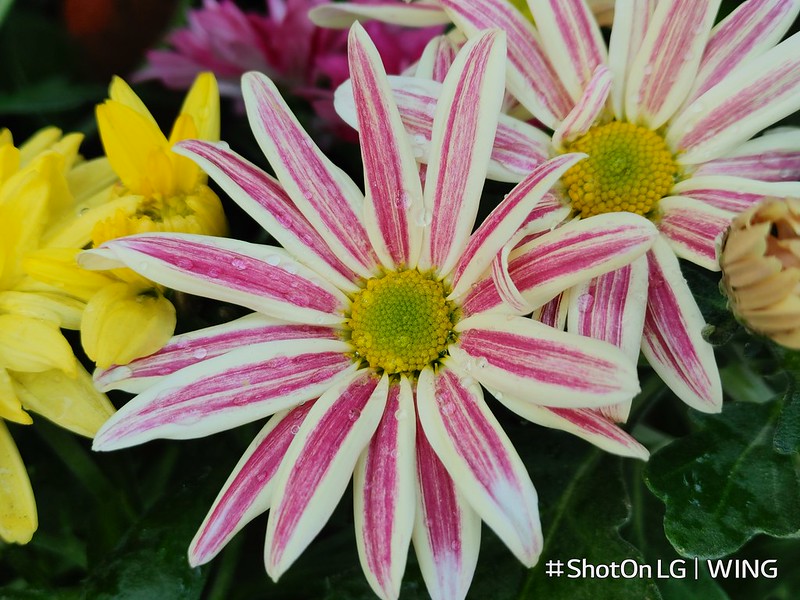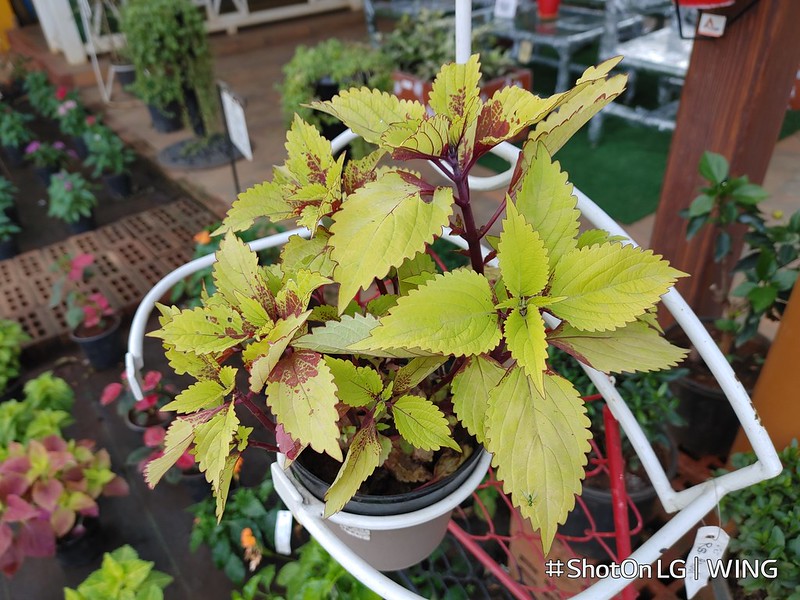LG Wing 5G Review: A Sidekick Among Foldables
- The LG Wing 5G is an innovative dual-screen smartphone where the primary display swivels to reveal the secondary screen.
- Under the hood is a 7nm Snapdragon 765G SoC with 8GB RAM and up to 256GB storage.
- The smartphone supports 5G, wireless charging and a special gimbal mode camera among other features.
LG, which was once the third-largest handset manufacturer globally, has been struggling with its smartphone business over the past few years. When the smartphone era started,LGadopted Microsoft’s OS instead of Android and made a relatively late entry into the Android space. Despite the launch of some innovative devices, LG failed to captivate consumers, which also led to a change in strategy. Now, there are strong rumors that LG has finallydecided to consider withdrawalof its smartphone business. While there is no word on how soon it will happen, we have the innovativeLG Wing5G smartphone that was the company’s last major launch.
The LG Wing has managed to impress me with its unique form factor and some of the interesting use cases that it brings. Its day-to-day performance has been smooth and there is nothing major to complain about here. Even the cameras are capable shooters in different lighting conditions. Overall, LG has put a lot of effort into differentiating the Wing from other smartphones in the market. We talk about all that and more in our detailed review below.
Pricing and Strategy: Continues to Innovate Despite Strong Headwinds
The LG Wing retails for $999 in the US for a 256GB storage model. In other countries, LG is offering a 128GB model for roughly the same price. In India, however, it received a price cut just a few weeks after the launch and is now available for around $825.
Commenting on LG’s strategy and positioning, Counterpoint Research Senior Analyst Sujeong Lim said, “One of the problems LG had was that the positioning of the so-called ‘affordable premium’ that it wanted to show through Velvet or Wing was ambiguous. With the G-series, they have built up an image of a specialized smartphone with good audio and camera performance. But since then, LG has lost its brand image. It was a difficult choice – whether to target consumers who want a premium smartphone, or those who want a mid-to-low end smartphone. And this issue had nothing to do with product performance and quality.”
On the rumors of LG exiting the smartphone business, Lim said, “It seems that the final decision on the direction of the LG smartphone division has not yet been made. However, it is unlikely that LG, which has a much higher proportion of mid-to-low end sales, will sell it while leaving only premium lines. We think that a full withdrawal is more likely.”
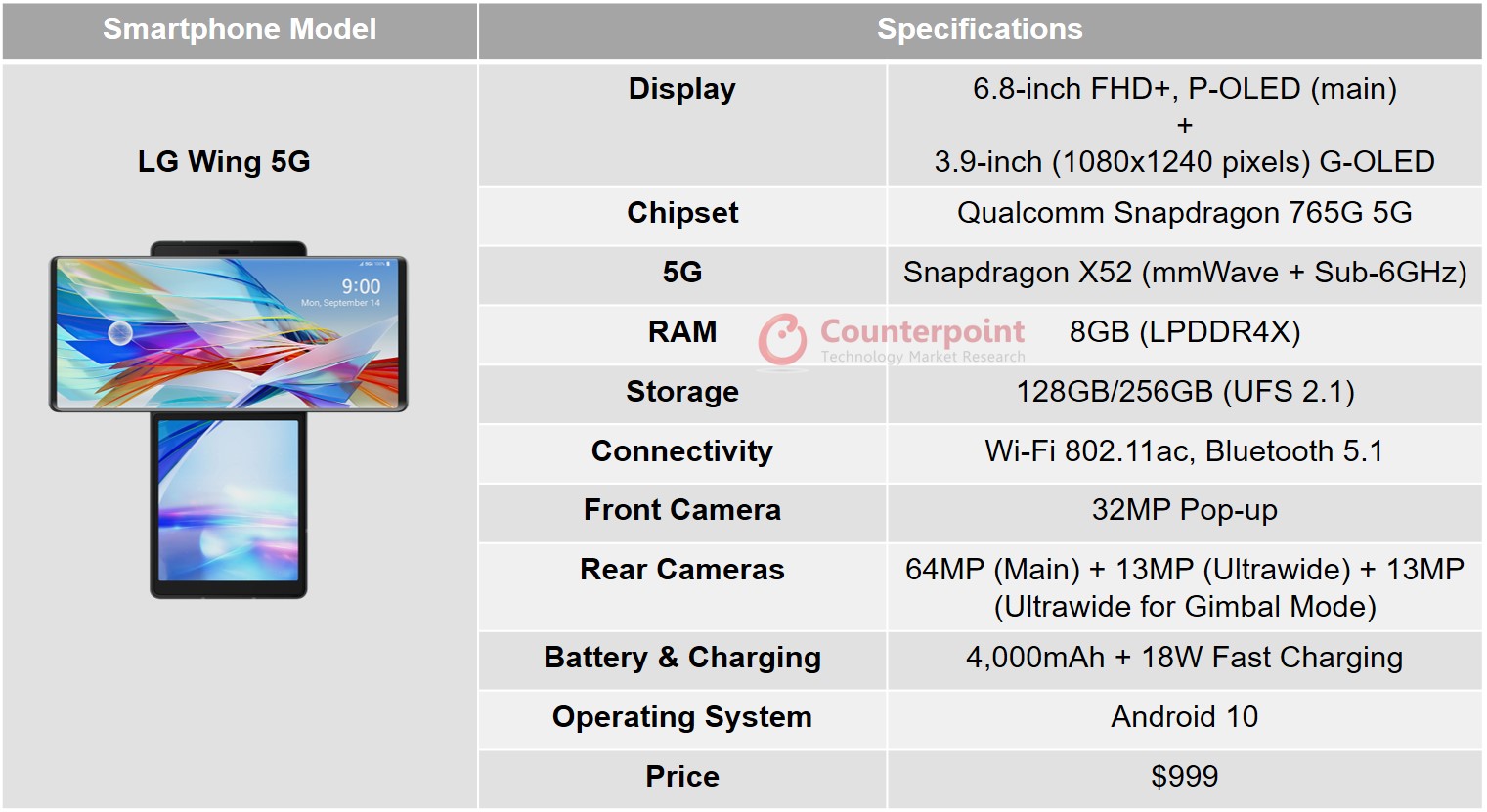
Design: Form Factors are Exciting Again
Before the smartphone era, we saw some iconic standout designs from Samsung, Nokia, LG, BlackBerry, and others. But as we transitioned to smartphones, the form factor largely remained the same – a candy bar design. Samsung, Motorola and Huawei have already debuted folding display smartphones, but there is still some time before we see an uptick in their adoption.
Coming back to LG, the company has always been ahead on the innovation front. The G5 was LG’s take on modular smartphones, but it failed to capture interest. With the V10, LG introduced a secondary display where you can see the time and notifications, and have app shortcuts and even quick settings such as Wi-Fi, Bluetooth and Torch toggles. The G8X and Velvet introduced an innovative dual screen in the form of a cover accessory. You can use the secondary screen to extend the display or use it as a joystick when playing games, among other uses.
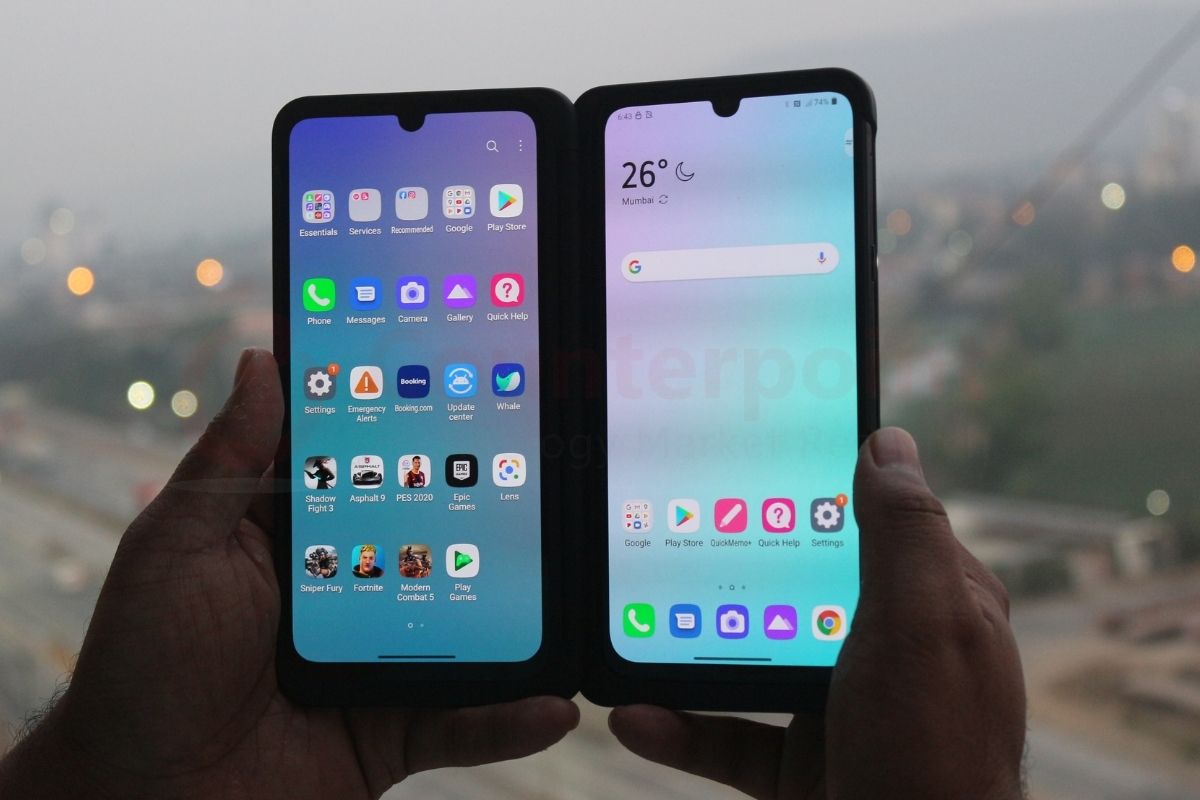
The LG Wing brings aunique swivel screenthat rotates horizontally to reveal a second 3.9-inch OLED screen at the bottom. In the open position, the Wing forms a T-Shape. From the design point of view, the Wing is an engineering marvel, especially if you look at how the mechanism works. But this is not LG’s first smartphone with a swivel mechanism. If you remember the U960 and KU950 feature phones that were launched in 2007, both had a similar design. The swivel screen revealed the T9 keyboard back then, whereas the Wing reveals a second screen.

But a lot has changed in the past 13 years. The Wing now comes with an MIL-STD-810G rating for durability, which means it can survive temperature variations, and “some” accidental falls. There is an IP54 rating for dust and water resistance too, but with a design like that, it would be better to keep it away from water. Overall, the swivel mechanism is smooth and snappy. You also get a satisfying click when the display opens up.
LG has done a commendable job with the Wing’s form factor, showing us different possibilities.
The Wing also offers a full-screen display, with curved edges. There is no notch or hole-punch cutout either. This is made possible thanks to the pop-up front camera. But the screen and form factors make it thick and bulky at 260 gm. You can instantly feel how heavy it is when you hold it in your hands. At the same time, this is the case with almost all 5G smartphones today – the Wing has to accommodate the antennas for both mmWave and Sub-6GHz.

However, all this innovation that LG has put in the Wing raises a few questions. Are there some interesting use cases for this form factor or is it just another gimmick?
Second Screen Use Cases: Better Gaming, Navigation and Multimedia Experience
讲规范,主屏幕features a 6.8-inch P-OLED panel running at full HD+ resolution (1080x2460pixels). The secondary screen is a 3.9-inch OLED which runs at a resolution of 1080x1240pixels. Both screens offer ample brightness, good viewing angles and deep blacks. Colors look vivid, without feeling too oversaturated. The main screen also carries WideVine L1 certification, allowing you to stream HD content on OTT platforms.

So how does the LG Wing take advantage of the dual screen? The best use case comes when playing certain games such asAsphalt 9: Legends,or when watching videos, as it benefits from the horizontal screen. When playingAsphalt, the main screen gives you the controls for braking and nitro, whereas the second screen shows the map. It works both ways – with the screen upwards or downwards. But this feature is limited toAsphalt, probably because of LG’s partnership with Gameloft. I was hoping for something similar when playing games likeCall of Duty: MobileorPUBG Mobilebut that does not work.
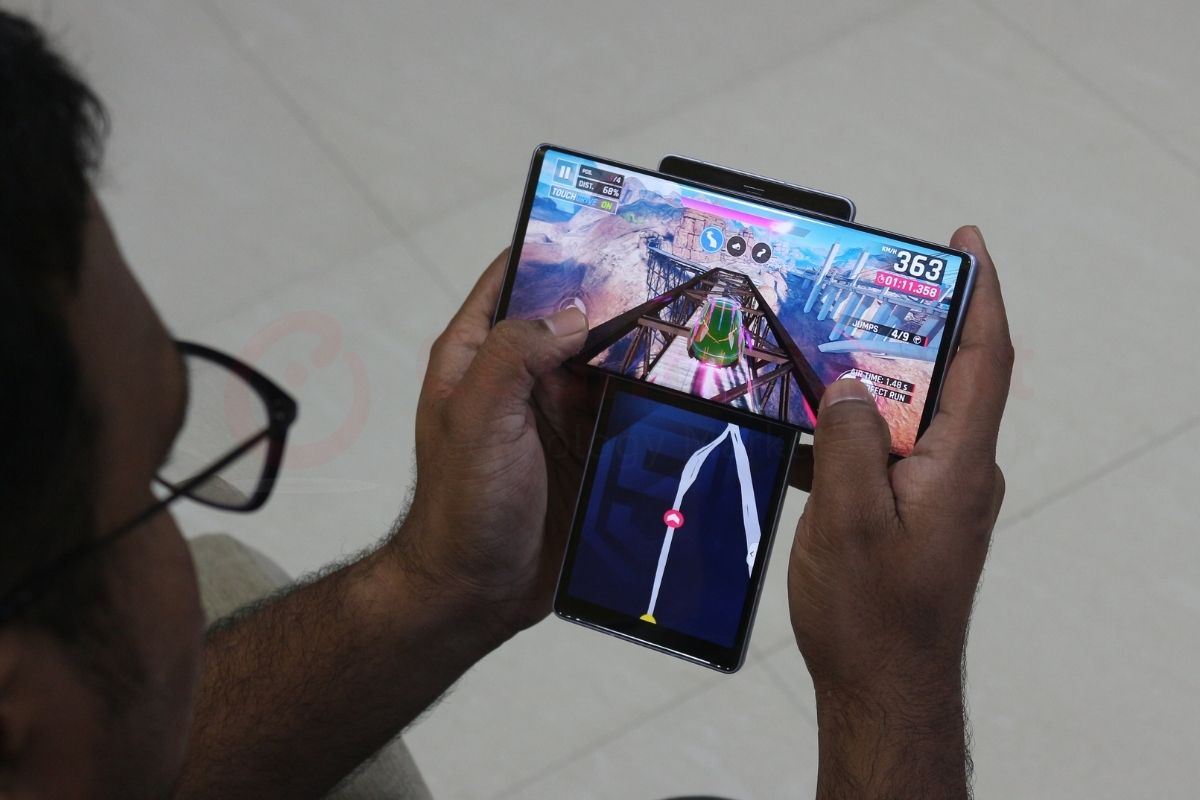
Games like ‘Asphalt 9: Legends’ make the best use of the secondary display while gaming.
The next use case is when you are watching YouTube. You can enjoy a full-screen viewing experience on the main screen, whereas the bottom screen gets Play/Pause/Skip, volume and brightness controls. You can also use the bottom screen to text via SMS or WhatsApp, check emails, scroll through your Twitter timeline, and more.

One use case I find interesting is where I like to live-tweet when watching EPL or Champions League football matches. And this is where I constantly keep minimizing the screen, open another app, tweet, and repeat. But the Wing solves this problem. I can continue streaming the match on the main screen while I tweet from the bottom screen or visit the EPL app and read live commentary and reactions.
Sports enthusiasts will appreciate the use case where they can watch a match and tweet about it without closing the streaming screen.
Other than that, you can use multiple apps in combination with the second screen. Like in the example above, we have Google Maps running on the main screen, and the Photo Gallery app on the secondary screen. You can even play games on the main screen while texting with your friends on WhatsApp or Messenger on the second screen. So, there are some valid use cases that the new form factor brings, and these will be helpful for those who multitask.
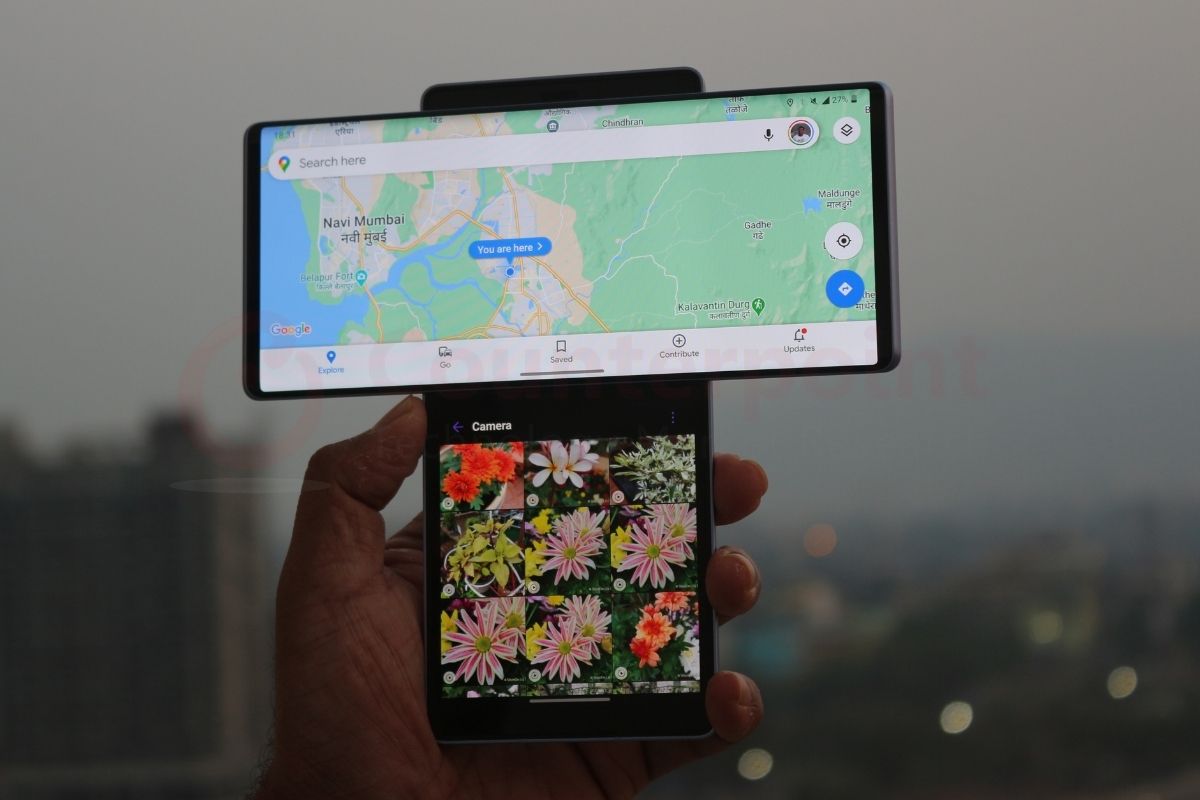
Cameras: Good Still Photography and Smooth Video Recording with Gimbal Mode
The LG Wing comes with triple cameras at the back with a 64MP primary sensor, f/1.8 aperture, and support for Phase Detection Auto-Focus (PDAF) and Optical Image Stabilization (OIS). Then we have a 13MP sensor with an ultra-wide-angle lens having an aperture of f/1.9 and field of view (fov) of 117 degrees. It is used for still photography when the screen is in a folded position.
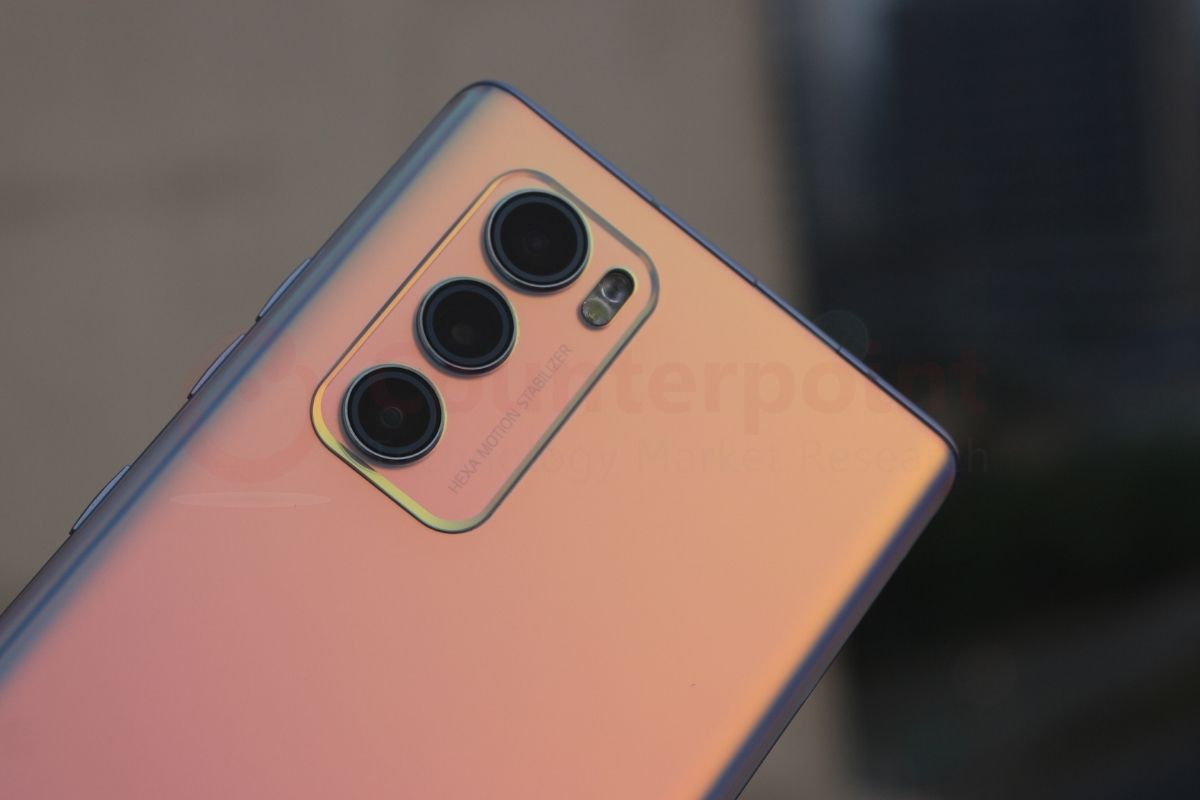
摄像机可以点击好照片daylight conditions. The photos are detailed with a good dynamic range, and colors look natural too. No immediate color shift is noticeable when switching from wide to ultra-wide lens, which is good. But some barrel distortion is noticeable around the edges. While there is no telephoto lens, the camera does offer 2X zoom where it uses the high-resolution sensor to crop in the image to offer lossless digital zoom. The zoom shots look good too while preserving details. Below are some ultra-wide, wide, and 2X zoom shots.
Close-up shots taken from the camera also offer good details while retaining accurate colors. In the examples below, you can see the flowers and the details on the leaves. Even the colors on the plant leaves look punchy without looking too gaudy.
In the next photos, the camera manages to focus on the cupid and Buddha statue while offering a nice background blur that looks natural. If you zoom in on the photo, you will be able to see the details more clearly.
Moving on, the camera also offers portrait mode where the subject is in focus and the background is blurred. Edge detection works well in separating the background from the subject. LG has also added a bunch of fun and exciting modes that let you play around with the portrait mode while adding a nice touch to your photos. For instance, you can keep the subject in color while keeping the background in black and white. You can also add zoom blur effects. There is also a portrait lighting effect with mono and color modes. They all work well, allowing you to share fun and interesting photos on social media.
Low-light photography on the smartphone is a little weak. In the night mode, you only get to adjust the exposure control, but it would have been better if LG also allowed to control the shutter. By default, it clicks shots at multiple exposure levels in just one second, and so there is no visible difference in the photos shot with default and night modes. Only when there is pitch darkness, the shutter is open for about five seconds, but that does not result in a bright photo most times. Below are sample shots in the default and night modes.
For selfies and video calling, LG has added a 32MP high-resolution motorized pop-up front camera. With an aperture of f/1.9, the camera clicks detailed photos while retaining accurate skin tone.
The portrait mode also works well, and the edge detection is good too, without making the background too aggressive.
Now coming to the third camera, LG has added a 12MP sensor, which also features an ultra-wide-angle lens. It has an aperture of f/2.2 and an fov of 120 degrees. This camera activates only when you open the primary screen and turn on the camera. You get a gimbal mode to record smooth cinematic footage with the camera. LG is using a special “hexa motion” sensor for stabilization.
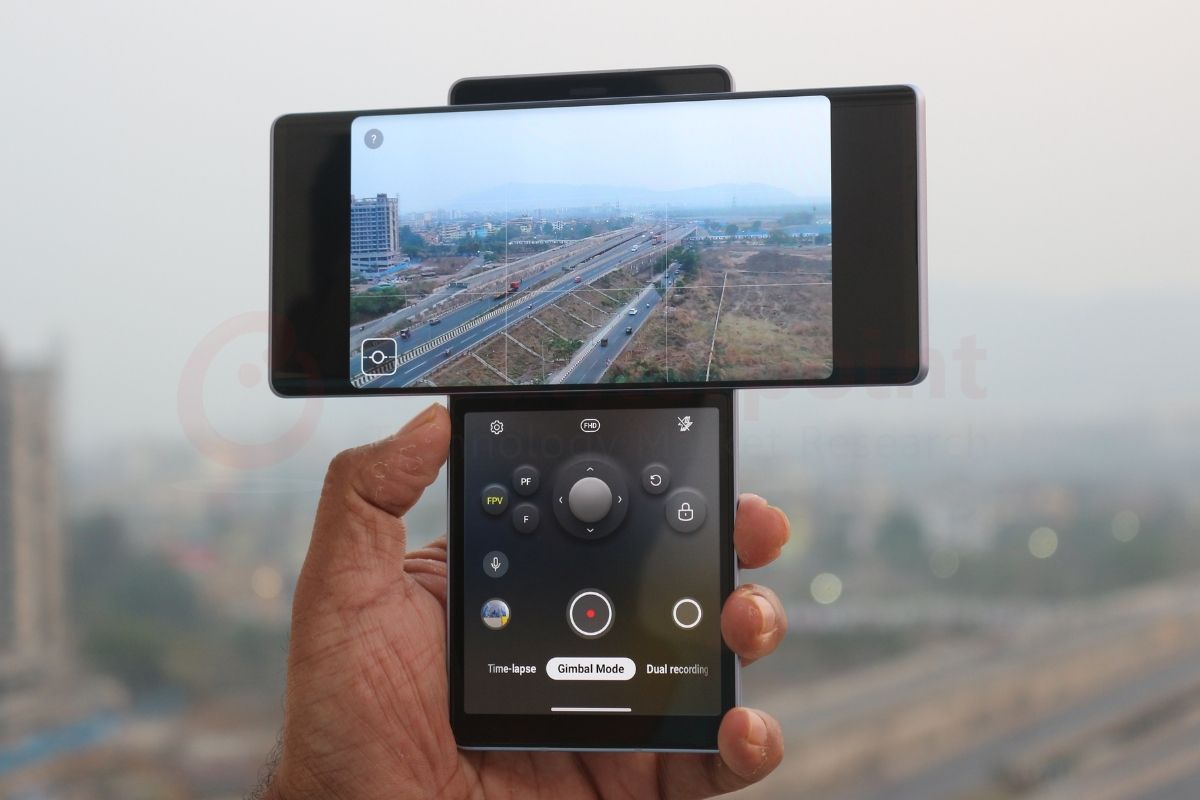
The gimbal mode is a neat software trick that works well in capturing stabilized videos in good lighting conditions.
One of the notable camera features is where LG takes advantage of the Wing’s “T” shape design. The main display works as a viewfinder to show the footage, whereas the bottom panel works as a grip. It features gimbal controls such as Pan Mode, Follow Mode, and a joystick to mimic a real gimbal. But it is a software implementation, where unlike the gimbal, the camera does not rotate on the axis. Instead, LG is cleverly doing digital cropping using the ultra-wide field of view, to offer wide footage.
The dual video recording is another interesting feature I found on the#LGWing. Vloggers will find this feature quite handy.@LGUS@LGIndia@LGUSAMobile@CounterPointTRpic.twitter.com/ey7NK8GGrI
— Ritesh Bendre (@GadgetFreak4U)February 13, 2021
Performance: Smooth Day-to-Day Usage, Balanced Battery Life
At the heart of the LG Wing runs a 7nm Snapdragon 765G SoC. It features one prime Cortex-A76 core at 2.3GHz, one performance core at 2.2GHz, and six Cortex-A55 efficiency cores at 1.8GHz. The chipset is paired with 8GB of RAM and 128GB/256GB UFS 2.1 storage. It is not the fastest one around but offers good read-write speeds. Apps open quickly, multi-tasking is a breeze, and there is no noticeable lag. Though the UI feels a little slow, that is mostly because of the lack of high-refresh-rate display.
A high-refresh-rate display, slightly bigger battery and faster charging capabilities could have been good additions.
Otherwise, I have no complaints about day-to-day usage. My usage includes a bit of gaming and scrolling through social media – Instagram, Twitter and Facebook timelines. I also use Feedly a lot to keep track of the daily news cycle. With all this usage, the performance was smooth, and the battery easily lasted a working day with a screen-on time of around five hours and 30 minutes. When using both the screens, the screen time would drop to four hours and 40 minutes or so.
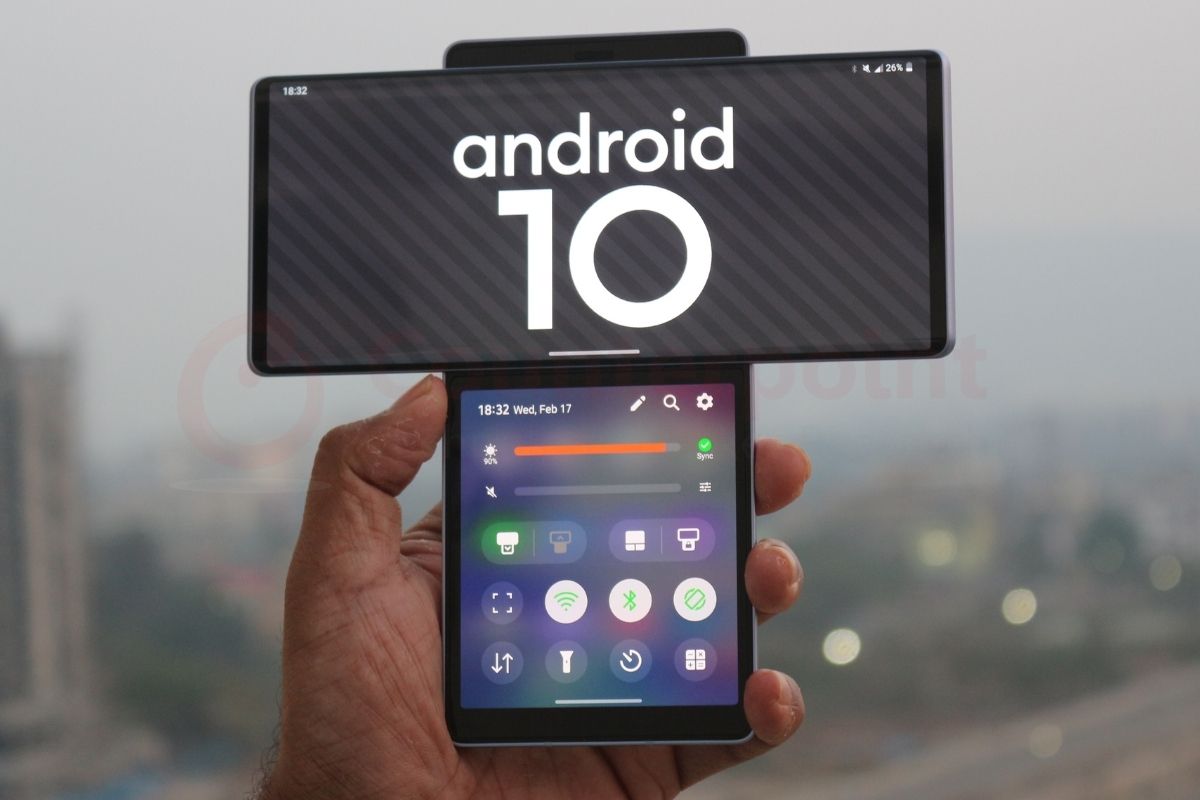
在软件方面,LG翼穿心莲内酯id 10 OS with LG UX on top. The custom skin has quite matured over the years and includes some interesting features like Smart Doctor that lets you optimize your phone by clearing temporary files, cache and RAM. It also lets you test different hardware functions such as the proximity sensor, accelerometer and gyroscope. LG has also included context awareness to automatically activate profiles based on whether you are at home, at work, away from home, and more. It is mid-February but the smartphone is running on the January security patch. Given LG’s uncertainty around its mobile business, it will be interesting to see how the company supports users on the software front.
Conclusion: Interesting Concept with Fewer Use Cases
The LG Wing is undoubtedly one of the best-looking smartphones in the market that will make heads turn. Besides the interesting form factor, the swivel mechanism is an engineering marvel. With the Wing, LG has tried to showcase its innovative side, but like its previous attempts, the company has not been able to highlight and market its strengths.
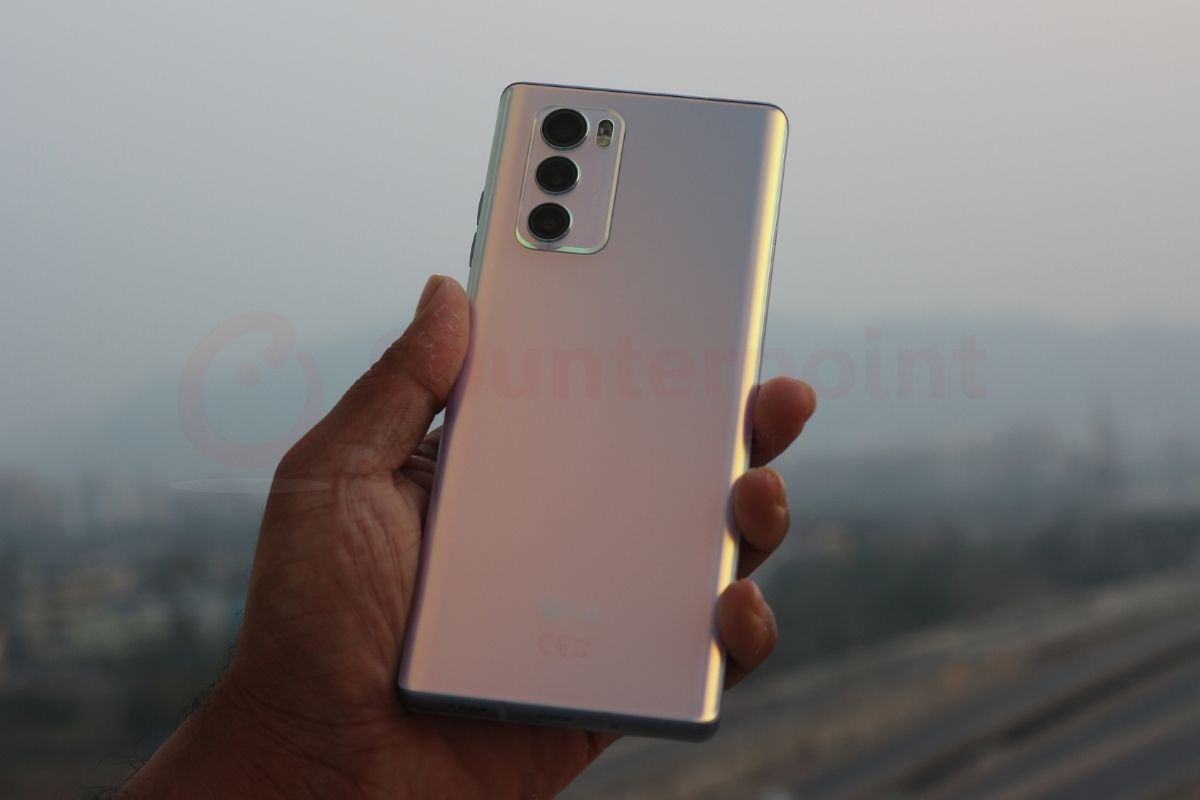
There are a few barriers with the Wing though. Firstly, the fingerprint sensor is out of reach to unlock when you flip out the screen from sleep mode. Essentially, one must first unlock the phone and then open the screen. A rear or side-mounted fingerprint reader could have solved this problem.
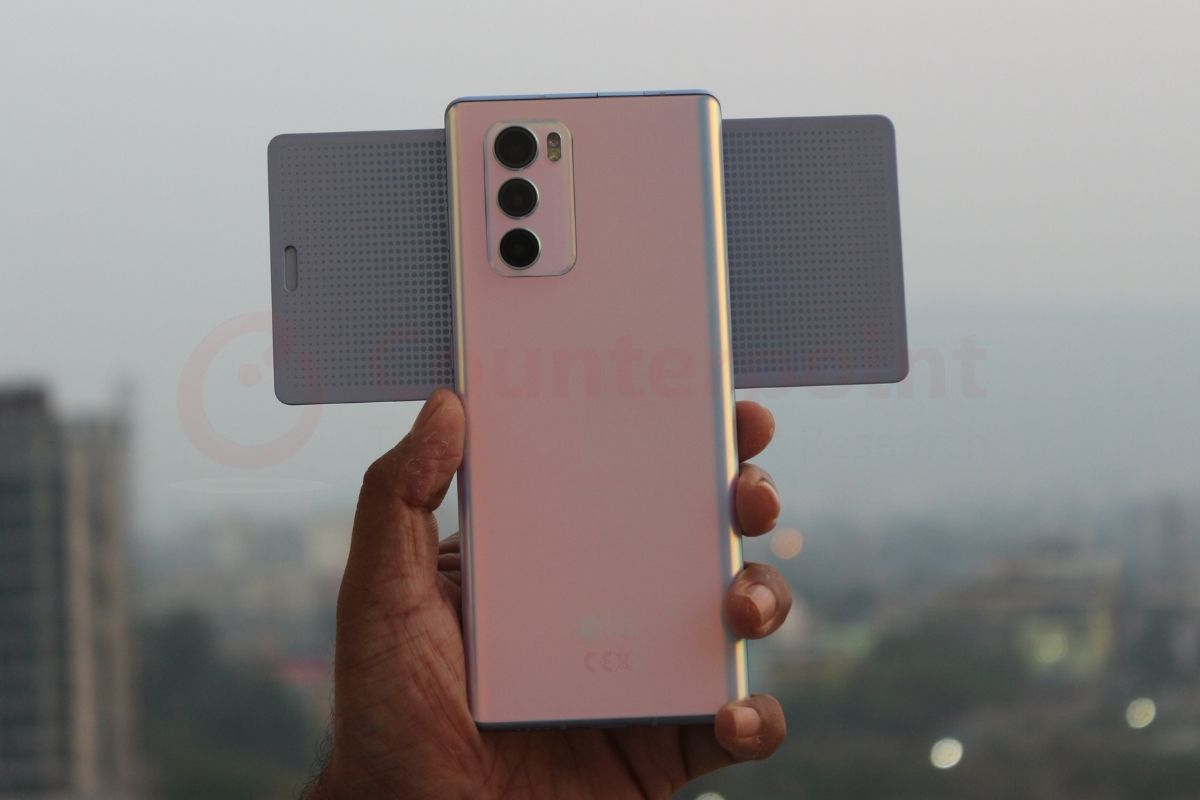
Moving on, though the concept of the “T” shape dual-screen sounds interesting, the use cases are extremely limited. LG could have partnered with more app and game developers to take full advantage of this concept. The main screen with a 90Hz refresh rate and above could have made it a better proposition. Lastly, the low-light camera performance can be improved further with updates. Even a fix for barrel distortion on ultra-wide-angle shots could offer a better photography experience.
Also Read: Strategic Reviews and Insights on Latest Smartphones
- HONOR V40 Review: Stylish Design, Vivid Display, Fluid Gaming Experience
- Comparing Mid-range 5G Smartphones for Around $700 and Below
- vivo V20 Pro 5G: Impressive Design, Capable Cameras and 5G Make it a Promising Upgrade
- Google Pixel 4a Review: Compact Camera for Stunning Still Photography
- Samsung Galaxy Note 20 Ultra 5G Review: Pinnacle of Android Flagships
- Vivo X50 Pro: A Camera Disguised as a Smartphone
- Asus ROG Phone 3 Review: Gold Standard for Gaming Smartphones
- Micromax In Note 1 Review: Noteworthy Comeback, With Room for Improvement


